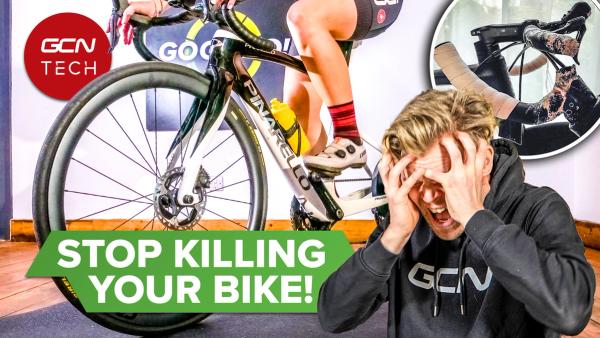Solid tyres, thru axles and TPU tubes: GCN Tech Clinic
Ollie Bridgewood is taking a look at groupset upgrades and tubeless repair concerns in this week's Tech Clinic
Alex Hunt
Junior Tech Writer
While Alex Paton is off at the Santos Tour Down Under, Ollie Bridgewood is left to his own devices in the Tech Clinic, taking a look at the latest tech and maintenance questions you have sent in. On the table are TPU inner tube repairs and how to go spare kit free with a pneumatic tyre.
Should I upgrade from Shimano Ultegra 11-speed mechanical to 105 Di2 or Ultegra Di2?
Both groupsets are incredible to use. Shimano’s 12-speed electronic groupsets are all amazing and as far as performance is concerned they are fairly comparable. Ultegra and Dura-ace might have slightly crisper shifting but on the whole, the biggest actual difference between them is the overall weight. 105 Di2 will weigh more than 11-speed Ultegra mechanical and 12-speed Ultegra Di2, however, if you are looking purely to upgrade for electronic shifting then 105 will be more than sufficient.
You should also look at how much chains, cassettes and chainrings cost to replace as these are consumable drivetrain items. If the cost of an Ultegra cassette is too much and you think you would find yourself reaching for a 105 cassette when the time comes to replace it, it would make sense to go with the 105 Di2 group and save yourself some of the additional cost.
As Ollie says, Di2 groupsets are expensive and have a significant outlay. If your 11-speed Ultegra mechanical groupset is working fine then why replace it? Save some cash and put it towards other upgrades, or towards a riding holiday instead.
If I use a Dynaplug am I at risk of damaging my rims?
For those of you who have not used a Dynaplug tubeless repair plug before they have a small brass head that helps with the insertion into the tyre. This brass head sits inside the tyre once the plugging tool is removed. We have had a few questions regarding the potential implications of this and whether having a small brass head inside the tyre could cause damage to the rim if the tyre bottomed out on a pothole or something similar.
If you have ever seen inside a tyre that has had a Dynaplug installed you will see that the brass head sits only just inside the surface of the tyre. This means that it will not rattle around but there is arguably a slim chance that with a harsh impact, the brass head could be enough to penetrate the rim tape so this could be something to be mindful of.
We have also had a few questions sent in regarding plugging sidewall punctures. The reality is that this area of the tyre is very hard to plug well and can often be the end of the tyre's tubeless life. It can be salvaged by running an inner tube but it is unlikely a tyre with a sidewall puncture will retain its integrity.
TPU tubes are losing 10psi overnight, what could be causing it?
There could be a few things at play here that are causing the tyre to deflate overnight. Firstly you could have a very small puncture in the surface of the inner tube. If the tube is new or there is no sign of puncturing to the surface of the tyre the most likely cause is that the valve of the tube is leaking air.
This can be tested by spraying a soapy water solution around the valve and seeing if any bubbles form. If this does look to be where air is escaping from you can tighten the actual valve head, as well as use a valve core tool to check that the valve core itself is also tight.
Can TPU tubes be repaired once they are punctured, or do they have to be replaced?
TPU inner tubes can be repaired and just watch this space as we have a ‘how-to’ video coming on just how to do this in the coming weeks. Pirelli manufactures TPU repair kits with small patches of TPU materials, however, the process does deviate a little from the standard process used on butyl tubes.
I have a bike with dropout and would like to convert it to thru-axles, what is the best way to do this?
The simple and frank answer to this is don’t. Modifying the dropouts of your bike is something that we certainly don’t advise here at GCN. The chances of it failing or not working properly in the first place is high and the frame was never designed to be used in that way. If it was us we would keep the bike as it is and look at a new purpose-built frame with thru-axles if that is something you want to use.
Is there a solution for not requiring air in my tyre? Can I use foam or something similar so I don’t need to carry spares?
Solid tyres do exist however they do have significant drawbacks, one of which being the significant increase in rolling resistance over a standard pneumatic tyre. Solid tyres can also be very harsh and lack the grip and control that you might be expecting from a tyre
We would recommend that you remain with a pneumatic system as it simply is the best option for a bicycle. Something you can do to increase the puncture resistance is to use a harder-wearing tyre. Something that will be a little heavier and a little slower rolling but will give you grip, comfort and puncture resistance.
In addition to this, they could then be fitted with run-flat liners that protect the rims if or when a puncture does occur. These use a high-density foam that holds the shape of the tyre even if you do puncture. This is more of a get-you-home measure but for commuting or riding around a city they would be enough to remove the need to carry spares over short distances.
Can you use a 12-speed bike on a trainer with an 11-speed cassette if you only use ERG mode?
This is a tough one to say. The best practice would be to only use the correct speed cassette for the bike you are using. It would be possible to use the 12-speed bike in ERG mode in the 11-tooth sprocket as this should be in the same relative position for both bikes.
This should mean that the chain will mesh without skipping and jumping around. The cassette will be a slightly different gauge to the chain, so there is the potential that under high loads the chain could jump. For steady-state efforts this could be a workaround, however we certainly wouldn’t advise this as you could accelerate the wear of your drivetrain and components.
Also, although ERG mode is very popular for indoor training it also isn’t as beneficial as free rides, this is because ERG mode is not representative of riding out on the road. Riding at a fixed output can allow you to achieve higher power targets but also takes the element of pacing and effort management out of the equation that is necessary when out on the road.
Got a tech question you want answered? You can leave it under the comments of this YouTube video or in the comments section at the bottom of this article.














